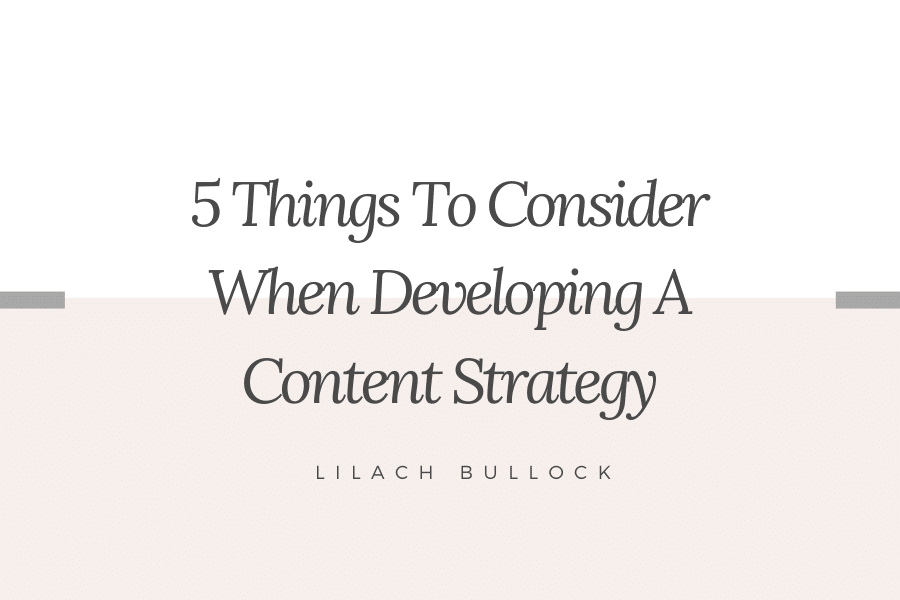Follow Lilach

5 Things To Consider When Developing A Content Strategy
While it’s true having content is one of the best ways to market your brand, simply posting a few blog posts and articles won’t automatically yield the results you want. Even more so if you don’t have a plan.
Essentials For Your Content
Developing a content strategy takes you to the drawing board to conceptualize ideas and put them into practice. Aside from considering Slickplan’s article about planning, enumerated here are some important factors you need for a killer content strategy.
1. Goal And Mission
Any content strategy should have a clear goal and mission to know the direction your organization is heading into. Consider what your marketing objectives are, what the needs of your business, and what your brand stands for.
Some of the goals a content strategy can address include:
- Nurturing leads
- Repeating customers
- Growing awareness for your products or services
- Changing people’s ideas
- Encouraging sales
- Supporting customers
Your goal will gradually change as your business grow, so make sure to periodically replan and revisit your content strategy objective. Keep them aligned with your needs and recalibrate the ones you think you’d need to improve.
2. Audience Persona
After the why, you need to consider the who. This is particularly important for those new to marketing. In terms of content, there’s no one-size-fits-all approach. This is a classic trap of trying to target everyone only to end up targeting no one.
If you’re speaking to everyone at the same time, then no one will truly feel like your blogs are written for them. Defining the target audience of your content can help you produce more valuable and relevant materials people will want to read, increasing the chances of conversions.
3. Content Kinds
You should think about what types of content you’d want to have. There are various kinds every content strategy should include depending on the purpose of the post.
Blogs remain as core content for your marketing mix as they’re known to deliver effective results. Ideally, a blog post should be valuable, actionable, and sharable. Also, it should have various article types.
Videos are great means to engage visitors and to have them on your website longer. In addition, video marketing also helps reduce abandonment and increase leads. Meanwhile, visual content like infographics can also improve enticement.
Audio blogs and podcasts are also becoming more popular as delivery mechanisms to keep users engaged. Other content types you can include are eBooks, webinars, worksheets, and checklists, which are all great for improving lead generation.
4. Resources
The next thing you should consider is your resources. Who’ll be producing and maintaining the content? You have to identify who’d be in charge and who’d be responsible for delivering individual items. You can do everything in-house or outsource content production if you have limited human resources.
You also need to figure out how you’re going to create your content. Your team can write blog posts via online sharing platforms. Also, there’s free software for creating infographics and images. You’ll need equipment for creating professional videos and podcasting, not to mention arranging for hosting on various sites.
In addition, you should also consider tools for collaboration and content managing. An editorial calendar should be your top priority since it brings your strategy together. Plus, it also allows you and your team to view everything needed to be created, so collaborate in managing the submission and in meeting due dates. There’s plenty of calendar software your organization could try.
5. KPIs
How do you know if you’ve achieved your content goals? Measure the results by having key performance indicators (KPIs) in your strategy. Your KPIs can guide you in knowing whether you’ve reached your targets by indicating markers you can tick off from your list.
KPIs indicate what you want to attain with regard to search engine optimization (SEO), sales, traffic, revenue, and other aspects aligned with your overall digital marketing strategy.
Usually, KPIs have figures. Some examples of items you can measure are:
- Signups
- Revenue
- Site traffic
- Email subscribers
- Number of comments, shares, and mentions
In addition, you may consider measuring and tracking your expenditures as well as monitoring the price of making sales and obtaining leads.
Conclusion
Crafting a strategy with the help of the above considerations allows you to leverage your content to grow your business rather than sitting idly on your blog. Whether you’ve been creating content for a while now or just starting with your marketing, creating a content strategy can set you up for success and for seeing results in the long run.

Follow Lilach















